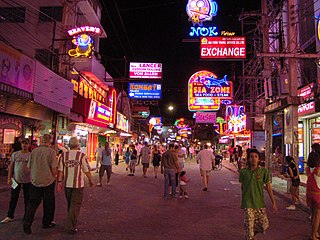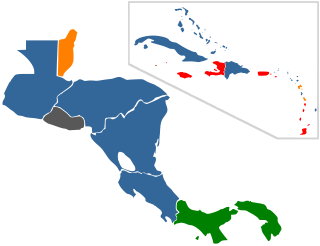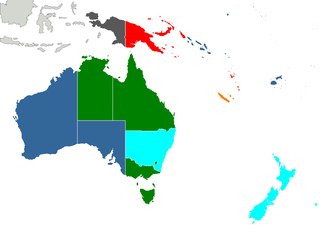Related Research Articles

Prostitution in Thailand is illegal. However, due to police corruption and an economic reliance on prostitution dating back to the Vietnam War, it remains a significant presence in the country. It results from poverty, low levels of education and a lack of employment in rural areas. Prostitutes mostly come from the northeastern (Isan) region of Thailand, from ethnic minorities or from neighbouring countries, especially Cambodia, Myanmar, and Laos. UNAIDS in 2019 estimated the total population of sex workers in Thailand to be 43,000.
Prostitution in Myanmar is illegal, but widespread. Prostitution is a major social issue that particularly affects women and children. UNAIDS estimate there to be 66,000 prostitutes in the country.
Prostitution in Greece is legal at the age of 18, and regulated. It is estimated that fewer than 1,000 women are legally employed as prostitutes and approximately 20,000 women, half of whom are of foreign origin and the other half are Greek, are engaged in illegal prostitution. Many women affected by the economic crisis have turned to prostitution through poverty.
Prostitution in Guatemala is legal but procuring is prohibited. There is an offence of “aggravated procuring” where a minor is involved. Keeping a brothel is not prohibited.
Prostitution in Senegal is legal and regulated. Senegal has the distinction of being one of the few countries in Africa to legalize prostitution, and the only one to legally regulate it. The only condition that it is done discreetly. Prostitution was first legalised in 1966. UNAIDS estimate that there are over 20,000 prostitutes in the country. The average age for a sex worker in Senegal is 28 years old and female.
Sex work in Venezuela is legal and regulated. The country's Ministry of Health and Social Development requires sex workers to carry identification cards and to have monthly health checkups. Prostitution is common, particularly in Caracas and in other domestic tourist destinations. The Venezuelan sex work industry arose in conjunction with the oil industry of the twentieth century and continues today.
Prostitution in Paraguay is legal for persons over the age of 18, but related activities such as brothel keeping are prohibited. Prostitution is common in the country. Brothels are also common, even some rural villages have a small bar/brothel on the outskirts.
Prostitution in Belize is legal, but the buying of sexual services is not. Associated activities such as operating a brothel, loitering for the purposes of prostitution and soliciting sex are also illegal.
Prostitution in Georgia is illegal but widespread, particularly in the capital, Tbilisi. Many NGO's attribute this to the harsh economic conditions according to the US State Department. Prostitution occurs on the streets, in bars, nightclubs, hotels and brothels. UNAIDS estimate there are 6,525 prostitutes in Georgia.
Prostitution in El Salvador is not prohibited by national law, but may be prohibited by local municipal ordinances. Municipal ordinances may also prohibit the purchase of sexual services. Related activities such as facilitating, promoting or giving incentives to a person to work as a prostitute (pimping) are illegal. The prostitution of children is also illegal. Brothel ownership, however, is legal. There are no specific laws against human trafficking, but any criminal offence that includes ‘commerce in women or children’ requires sentencing to be increased by 30%.
Prostitution in Kenya is widespread. The legal situation is complex. Although prostitution is not criminalised by National law, municipal by-laws may prohibit it.. It is illegal to profit from the prostitution of others, and to aid, abet, compel or incite prostitution.. UNAIDS estimate there to be 133,675 prostitutes in the country.
Prostitution in Zambia is legal and common. Related activities such as soliciting and procuring are prohibited. UNAIDS estimate there are 9,285 prostitutes in the capital, Lusaka. Many women turn to prostitution due to poverty. Sex workers report law enforcement is corrupt, inconsistent and often abusive.
Prostitution in Guyana is illegal but widespread. Prostitution law is antiquated and dates from the colonial era. Law enforcement is inconsistent and sex workers report violence and abuse by the police. Many turn to prostitution for economic reasons and the lack of other job opportunities. Prostitution continues to receive greater public attention due to the high incidence of HIV/AIDS among prostitutes. Prostitution in the country is separated into three types: "uptown", servicing affluent clients, "downtown", servicing the working classes, and mining sites. UNAIDS estimate there to be 6,000 prostitutes in the country.
Prostitution in Namibia is legal and a highly prevalent common practice. Related activities such as solicitation, procuring and being involved in the running of a brothel are illegal. A World Bank study estimated there were about 11,000 prostitutes in Namibia.
Prostitution in Uzbekistan is illegal, but prostitution has increased within the country since the collapse of the Soviet Union. UNAIDS estimated there to be 22,000 sex workers in the country in 2019. Many of the women have turned to prostitution in Uzbekistan because of poverty.
Prostitution in Angola is illegal and prevalent since the 1990s. Prostitution increased further at the end of the civil war in 2001. Prohibition is not consistently enforced. Many women engage in prostitution due to poverty. It was estimated in 2013 that there were about 33,00 sex workers in the country. Many Namibian women enter the country illegally, often via the border municipality of Curoca, and travel to towns such as Ondjiva, Lubango and Luanda to work as prostitutes.
Prostitution in Ivory Coast is legal, but associated activities, such as soliciting, pandering or running brothels, are illegal. Sex workers report law enforcement is sparse and corrupt. Police sometimes harass sex workers and demand bribes or sexual favours. Transgender prostitutes are often targeted by police and soldiers and subjected to violence. It was estimated in 2014 that there were 9,211 prostitutes in the country.
Prostitution in Benin is legal but related activities such as brothel keeping and benefiting from the prostitution of others are illegal. UNAIDS estimates there to be about 15,000 prostitutes in the country. Most of these are migrants from neighbouring countries, mainly Nigeria, Togo and Ghana. Only 15% of the prostitutes are Beninese. Prostitution occurs on the streets, in bars, restaurants, hotels and brothels. With advent of the smartphone, many prostitutes use apps to make arrangements with clients.

Legality of prostitution in the Americas varies by country. Most countries only legalized prostitution, with the act of exchanging money for sexual services legal. The level of enforcement varies by country. One country, the United States, is unique as legality of prostitution is not the responsibility of the federal government, but rather state, territorial, and federal district's responsibility.

Prostitution in Oceania varies greatly across the region. In American Samoa, for instance, prostitution is illegal, whereas in New Zealand most aspects of the trade are decriminalised.
References
- 1 2 3 4 5 6 7 8 "Sex Work Law". Sexuality, Poverty and Law Programme. Retrieved 24 December 2017.
- ↑ Emerald, Daily (16 July 2007). "Ecuadorian brothels illuminate red-light truths" . Retrieved 9 January 2017.
- ↑ Crowder, Nicholas (15 October 2009). CultureShock! Ecuador: A Survival Guide to Customs and Etiquette. Marshall Cavendish International Asia Pte Ltd. ISBN 9789814435734 . Retrieved 9 January 2017– via Google Books.
- ↑ Adshade, Marina (21 April 2012). "The Price of Sex in South America: A Guide for Secret Service Agents" . Retrieved 9 January 2017.
- ↑ Cunningham, Scott; Shah, Manisha (10 August 2016). The Oxford Handbook of the Economics of Prostitution. Oxford University Press. ISBN 9780199915255 . Retrieved 9 January 2017– via Google Books.
- 1 2 3 4 Soguel, Dominique (10 April 2009). "Ecuador Sex Workers Target HIV-AIDS Prevention". Women's eNews. Retrieved 27 December 2017.
- 1 2 Crowder, Nicholas (2006). Culture shock!. a survival guide to customs and etiquette. Tarrytown, NY: Marshall Cavendish. ISBN 978-0761424956.
- ↑ "Sex workers: Population size estimate - Number, 2016". www.aidsinfoonline.org. UNAIDS. Archived from the original on 4 June 2019. Retrieved 21 July 2018.
- 1 2 3 "Quito: History and Prostitution". Andes Anthropologist. 30 March 2011. Retrieved 27 December 2017.
- ↑ Rosero, Mariela (19 October 2015). "Municipio participó de operativo de control a hostales cerradas" [Municipality participated in control operation to closed hostels]. El Comercio (in Spanish). Retrieved 27 December 2017.
- ↑ Rosero, Mariela (30 November 2015). "Administrador Centro propone habilitar temporalmente exhotel para el trabajo sexual en esa zona" [Administrator Center proposes to temporarily enable exhotel for sex work in that area]. El Comercio (in Spanish). Retrieved 27 December 2017.
- 1 2 "Ecuadorian brothels illuminate red-light truths - Emerald Media". Daily Emerald. 16 July 2007. Retrieved 27 December 2017.
- 1 2 3 4 Soguel, Dominique (1 May 2009). "Brothels in Ecuador Skirt Law Banning Minors". Women's eNews. Retrieved 27 December 2017.
- 1 2 3 Van Meir, Jessica (29 July 2016). "Sex Work in Ecuador: Conditions in Brothels and in the Street". Observations. Retrieved 27 December 2017.
- 1 2 3 4 Ditmore, Melissa Hope (2006). Encyclopedia of prostitution and sex work. Westport, Conn.: Greenwood Press. ISBN 978-0313329685.
- ↑ "Red de Trabajadoras Sexuales del Ecuador (REDTRABSEX)". The Communication Initiative Network (in Spanish). Retrieved 27 December 2017.
- ↑ Gumbel, Andrew (18 April 2005). "Paradise lost in the Galapagos Islands". The Independent. Retrieved 27 December 2017.
- ↑ "CHILDREN-ECUADOR: Child Prostitution is Growth Industry - Inter Press Service". 19 July 1996. Retrieved 9 January 2017.
- 1 2 "Country Reports on Human Rights Practices". U.S Department of State . Retrieved 8 March 2008.
- ↑ "Latina Women and Children at Risk". Indigenous & Latina Women & Children's Human Rights News from the Americas. Archived from the original on 6 May 2004. Retrieved 8 March 2008.
- ↑ Cova, Antonio de la. "Ecuadoreans cry for help in a region prone to HIV". www.latinamericanstudies.org. Retrieved 27 December 2017.
- ↑ "The World Factbook — Central Intelligence Agency". Central Intelligence Agency. Archived from the original on 13 June 2007. Retrieved 27 December 2017.
- ↑ Beckman, Adam L.; Wilson, Magdalena M.; Prabhu, Vishaal; Soekoe, Nicola; Mata, Humberto; Grau, Lauretta E. (22 November 2016). "A qualitative view of the HIV epidemic in coastal Ecuador". PeerJ. 4: e2726. doi: 10.7717/peerj.2726 . PMC 5126616 . PMID 27904814.
- 1 2 3 4 "Ecuador 2016 Trafficking in Persons Report". United States Department of State Office to Monitor and Combat Trafficking in Persons . Retrieved 24 December 2017.
 This article incorporates text from this source, which is in the public domain .
This article incorporates text from this source, which is in the public domain .